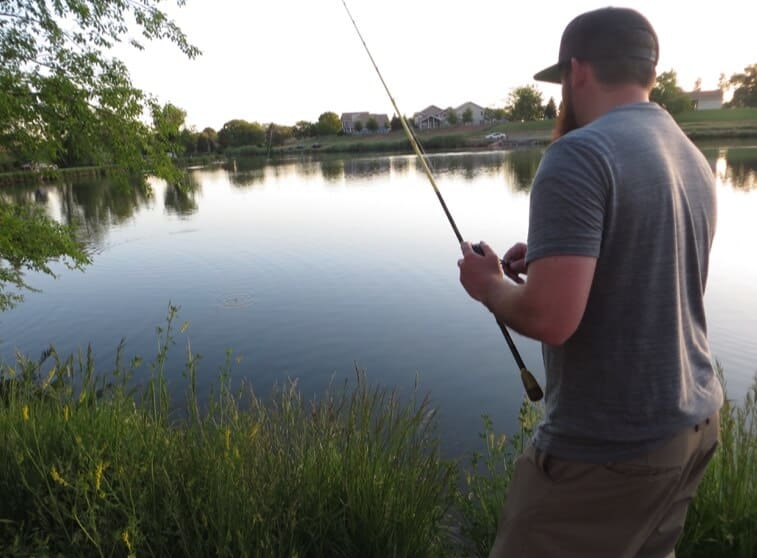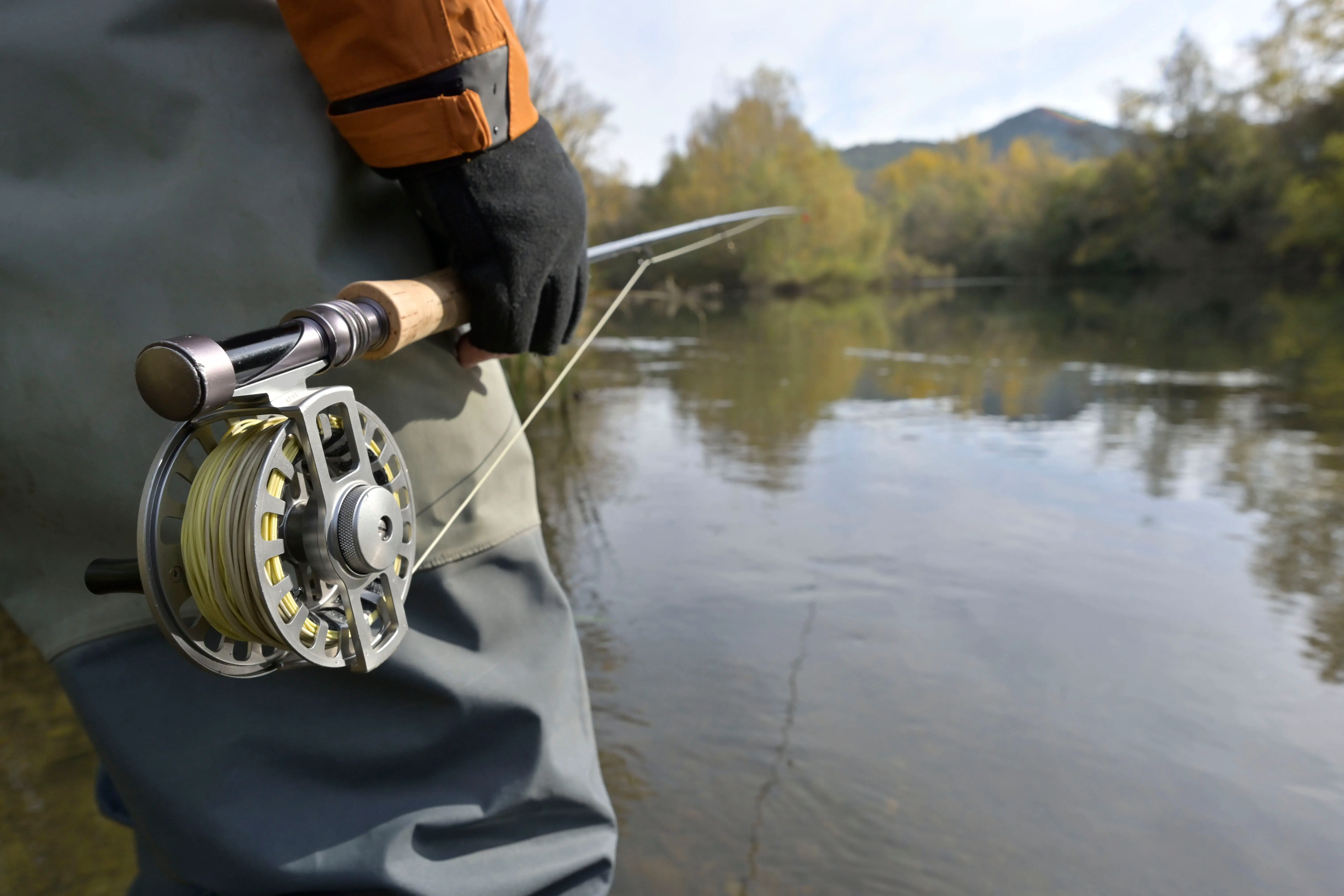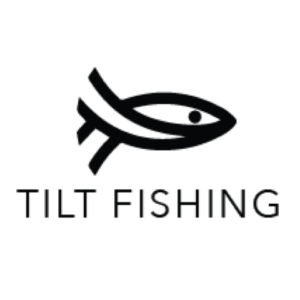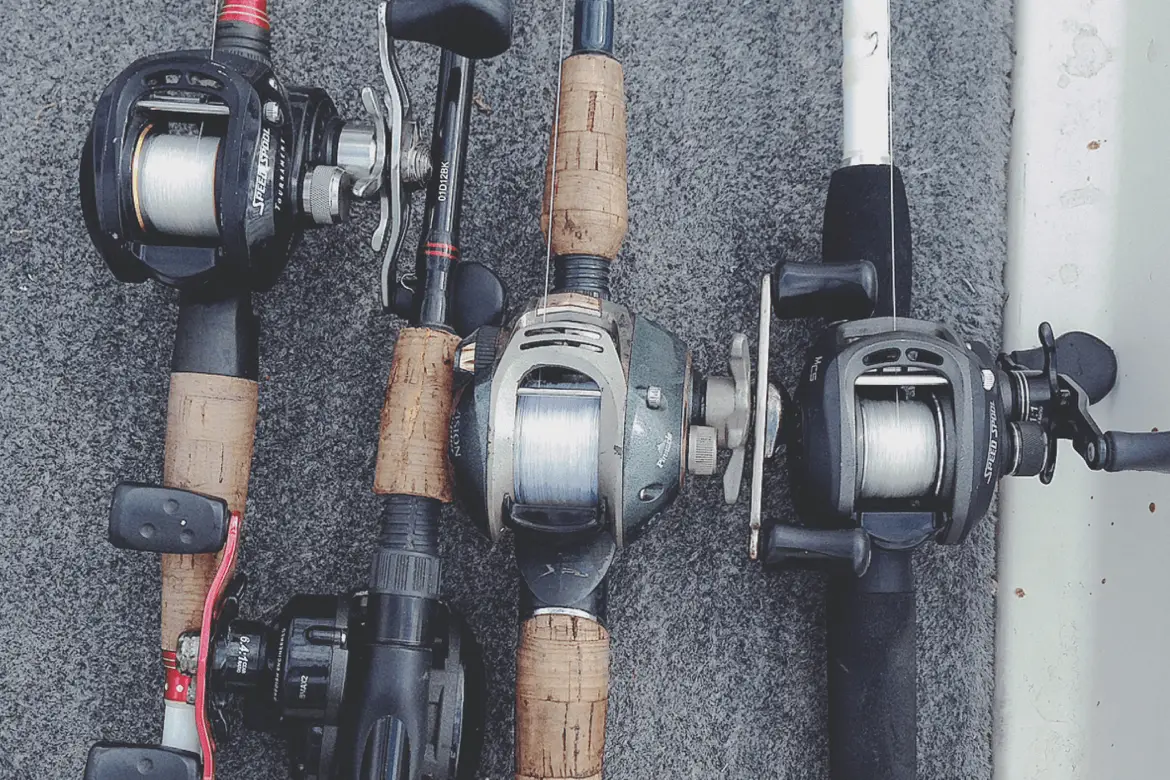Many anglers are unaware the fishing rod is one of the most important tools for catching and landing fish. Having the right fishing rod will make you a more accurate and successful angler. On the other hand fishing with the wrong rod can be frustrating and ineffective.
I’m often asked, “What size of rod should I be using?”. The truth is that each type of lure or angling method requires a different size and type of rod. The length of fishing rods can range from just 4 feet to a giant 14 foot rod. With each one having a time and place.
In this fishing rod size guide, I’ll share with you what are the best rod lengths for each angling method, fish species, and how to choose the right fishing rod that best matches your fishing style.
Best Overall Fishing Rod Size
The length of a fishing rod is a very important variable that will affect how a rod performs in any fishing application, as well as how comfortable the angler will be while doing it.
While there are extremes on each end of the spectrum, most modern fishing rods are somewhere between 5’6″ and 9′ in length, and the vast majority are in a sweet spot between 6’6″ and 7’6″ long.
In my experience, the best overall fishing rod length is between a 6’6” to 7’ that is medium powered and with a fast action. This rod length is the most versatile and is perfect for most fishing situations.
Although this rod length is the most versatile, it’s not perfect for all types of water or situations. In fact, ideally you’ll want to match your rod length, action and power with the type of fishing you’ll be doing.
How to Choose the Proper Fishing Rod Length
When selecting a fishing rod, one of the first things that you should consider is what size of rod you’ll need. The easiest way to select the right size rod is to first think about how you will utilize it.
A good rule of thumb to follow for rod length is: longer rods will cast further but aren’t as accurate, while shorter rods won’t cast as far but will be more accurate.
Shorter rods are ideal for close combat situations where accuracy is key. Longer rods are the most utilized when further casting distance is needed. Like throwing reaction style lures like crankbaits and top water lures where a more distance will keep your lure in the strike zone for longer.
Ultimately, rod length impacts four aspects of your fishing and should be considered any time you’re choosing the appropriate rod length.
Accuracy
Simply put, a shorter rod allows for more accurate casts. Shorter rods are also more manageable and tight corners and typically much easier to cast. A short rod is ideal if you want to make short accurate casts with point point accuracy.
Distance
In general the longer the rod the more distance you’ll be able to get out of your casts. Just keep in mind you won’t be as accurate. Longer rods are ideal when fishing moving baits like crankbaits where distance is extremely important and accuracy takes a back seat.
Leverage
Leverage is a key variable in any fishing rod and can be the difference between landing a fish of a lifetime or having one break off. Longer, heavier action rods will offer more leverage than shorter lighter action rods. This leverage helps when setting the hook and keeping tension on a hooked fish.
Comfort
An often overlooked aspect when it comes to selecting the right rod length is comfort. If you don’t get a rod that matches your height and comfort level you’re not going to enjoy your time using it. Keep the guidelines mentioned in this article in mind but don’t forget to adapt the length of your rods to what is comfortable for you.
For more insight on how to select the right rod size for your fishing style check out this article by abugarcia.com.
Best Fishing Rod Size for Each Species

As I’ve mentioned before you’ll want to match the size of your rod with the style of species of fish you are targeting. Each lure, technique and angling method might require a different size and type of fishing rod.
Here is a fishing rod guide based on the different fish species you might consider targeting.
Fishing Rod Length Chart
| Targeted Species | Best Rod Length |
| Bass | 6’10” to 7’4” |
| Trout | 6’6” to 7′ |
| Walleye | 6’6” to 7’4″ |
| Catfish | 6’6” to 9′ |
| Panfish | 4′ to 7′ |
| Saltwater Fishing | 6′ to 7′ |
| Freshwater Fishing | 6’6” to 7’2’ |
Best Rod Length for Bass
If you are an avid bass fishing angler you know there are a ton of different lures, techniques, baits, and rigs you can use to catch bass. With each technique having a preferred rod size, action and power.
In general, the best size of fishing rod to use for bass is a rod between 6’10” and 7’2” with a medium power and a fast action. In my opinion, a 7 foot medium powered rod is the most versatile rod to use and will help you catch bass on a variety of techniques and lures.
Here is a general rod length guideline for each bass fishing technique.
Best Rod Length for Trout
The best overall spinning rod size to use for trout is a rod that is between 6’6” and 7ft long. This size of rod is a perfect general purpose length that will help you effectively catch trout from the bank or from a boat. I’d recommend pairing this rod length with a medium or medium light powered rod with a fast action.
If you primarily fish big lakes where casting distance is more important I’d get a longer rod like a 7ft medium powered with a fast action. If you are fishing small streams a shorter rod would be ideal. Some anglers will use a rod as short as 5ft in these situations.
For more insight on selecting the right rod length for trout fishing check out this article by troutresource.com
Best Rod Length for Walleye
If you could only have one rod to use to target walleye with, then a 6’6” medium action rod would be the best overall rod. With this size of rod you can easily fish with jigs, troll and bottom bounce and fish other walleye catching techniques.
Another great rod choice for walleye fishing is a 7’ medium moderate action rod. This will give you a little bit more power and allow you to cast further.
For more insight on selecting the right rod for walleye fishing check out this article by fishidy.com
Best Rod Length for Catfish
When targeting catfish it’s important that you get a rod that can maximize your leverage when battling these big fish. That’s why you see many anglers targeting catfish using longer rods.
The best overall rod length to use when fishing for catfish is a rod that is between 6’6” and 9ft. You’ll also want to make sure you fish with a rod that’s rated for medium or heavy to give you the strength you’ll need to lang big cats.
Of course, the length and the strength of your rod should be determined by the caliber of fish you are planning on running into. If you are targeting smaller mud cats you can get away with a shorter rod. If trophy catfish is your goal a rod that is at least 7ft and that has heavy power will be needed.
Best Rod Length for Panfish
The ideal rod size to use when targeting panfish in my opinion is a 6’6” ultra light to medium action. Most panfish rods are typically between 4 feet and 6 feet, but there are some specialty rods out there that can be up to 12 feet long.
While some anglers prefer to use a longer rod, I’ve found a medium size rod to be more versatile and effective. I’d also recommend pairing your rod and reel combination with a 4lb fluorocarbon or monofilament line.
Most sporting goods stores will carry generic fishing rods and these can work just fine for panfish. However, you can also find some specialty rods that are dedicated to panfish like crappie that are ideal for this type of angling.
Best Rod Length for Saltwater Fishing
Much like freshwater fishing, saltwater is a broad topic and there are many speciality techniques, methods and species anglers like to target.
In general, the best and most versatile size of rod to use when saltwater fishing is a 6 to 7-foot medium-action offshore fishing rod paired with a heavy baitcaster reel and at least 20-pound test monofilament line. This setup can get you by for most saltwater applications. However, if you are bottom fishing you’ll want to upsize your line and your rod.
Best Rod Length for Freshwater Fish
When searching for a freshwater fishing rod at Walmart or a local sporting goods store the most common rod you’ll see is a fishing rod that is 6 foot or 6 foot 6 inches. This is your average run of the mill rod that most stores will carry.
In my opinion the best size rod for freshwater fishing is between a 6’6” to 7’2’. This length is the most versatile and is perfect for most freshwater fishing situations. I’d also make sure that the action of the rod is either medium or medium light with a fast action. This rod combination will be great fishing for trout, bass, crappie, panfish, walleye and other freshwater fish.
Best Fishing Rod Size for Each Angling Method

Fishing rods are like tools, with each one designed to perform a particular task or job. Matching the size of your rod with the type of fishing you’ll be doing can be extremely important.
Here are the best fishing rod sizes based on the different styles and fishing methods.
| Angling Method | Best Rod Length |
| Surf Fishing | 9′ to 12′ |
| Kayak Fishing | 6’10’ to 7’5’ |
| Fly Fishing | 7′ to 9′ |
| Jigging | 5’9” and 6’ |
| River Fishing | 6’6” to 7′ |
| Trolling | 7′ to 8′ |
| Ice Fishing | 24 to 32 inches |
Best Rod Length for Surf Fishing
In surf fishing bombing a long cast out to the middle of the sea can be extremely important and can result in more success. For this reason the best size rod for surf fishing is between 9ft and 12ft long. These longer rods will increase your casting distance and give you the ideal power for fighting larger fish.
On the other hand shorter rods less than 9ft long aren’t the best for surf fishing. You’ll have a hard time getting the distance you need in order to fish effectively.
For more insight on what the best size rod is for surf fishing check out this article by surfcastingrepublic.com
Best Rod Length for Kayak Fishing
When thinking about a kayak fishing rod the best length really depends on your fishing style and how you fish. If you stand up and fish out of your kayak you can get away with fishing with a longer rod. On the other hand if you prefer to sit and fish a shorter rod might be more beneficial.
In my experience the best overall fishing rod length to use while kayak fishing is between 6’10’ and 7’5’. If you are fishing around docks and trees where accuracy is important go with a smaller rod. If distance is more important than accuracy go with a longer rod that will allow you to cast farther.
Best Size Rod for Fly Fishing
In general fly fishing rods are pretty long when compared to other fishing techniques. The best overall size of fly rod is a 9’ rod, 5-weight. This is the most versatile fly rod and can be used in a variety of different ways.
Before you can decide what length of fly rod to use, you should first consider the type of water you plan to fish. If you are mostly going to fish on lakes on a boat or float tube a longer rod will be best for a longer casting distance. If you’re fishing small streams and in tight corners short rod length will be much easier to fish with. If you are looking for an all purpose rod that does everything I’d stick with a 9’ length that is rated as a 5 weight.
Best Rod Length for Jigging
The best size rod to use for jigging is a rod that is between 5’9” and 6’ long. A shorter compact jigging rod like this will increase sensitivity, be lighter and are much easier to use for this technique. Longer rods can work as well but tend to be much more limiting and not as effective.
Here are the details for an ideal jigging rod:
- Between 5’9” and 6’ long
- Medium light to medium power
- Fast to extra-fast action
- Dense handle material
- Graphite or carbon fiber blank
Best Rod Length for River Fishing
When considering what rod length to use when fishing in a river you should first determine the type of water you are going to be fishing. Are you fishing in small streams with tight corners and a lot of obstacles? Or are you fishing in a larger river with a lot of space to cast?
In general, the best rod length to use when river fishing is a 6’6” medium powered rod with a fast action. This is a versatile length that can be used in most fishing situations on a river.
If you are fishing in small rivers and streams a shorter rod like 5 footer might be easier to manage. When fishing larger rivers and big fish a longer size rod will help you get more casting distance.
For more insight on selecting the right size rod for river fishing check out this article by troutandstealhead.com.
Best Trolling Rod Length
In general trolling fishing rods tend to be longer than other types of rods and are often found between 7 and 11 feet long.
In my experience the best overall rod length to use when trolling is a rod that is between 7′ – 8′. This length gives you enough distance away from your boat, but isn’t too long making it easier to land and fight the fish once they are hooked.
One of the main reasons why extra length is preferred when trolling is because it makes it easier to troll with several rods at the same time, without getting lines crossed and tangled. A longer rod also helps when using down riggers and other trolling techniques.
More more information on what makes a good trolling rod check out this article by tightllinesandhightides.com
Best Ice Fishing Rod Length
Ice fishing rods are the shortest out of all the types of fishing rod, and are typically between 28 and 36 Inches. In my experience I have found the best rod length for ice fishing to be a rod that is between 25-to 28-inches.
For common ice fishing situations where anglers are targeting panfish, trout, and walleye most anglers use a rod between 24 and 32 inches. The reason why ice fishing rods are a lot short is because you don’t need to cast an ice fishing pole, and instead you just lower your lure or bait down vertically into the ice fishing hole.
A shorter rod will also be more sensitive, making it easy to detect bites and it makes grabbing the fish when you pull it through the ice much easier.
For more tips and information on ice fishing rod length check out this article by abugarcia.com
Other Important Fishing Rod Details
A fishing rod’s length is an important variable that will affect how well your rod performs and how comfortable the angler will be when using it. However, there are also other factors to consider as well.
Here are other important fishing rod components that you should also keep in mind when selecting a fishing rod size.
Fishing Rod Power
The power of a fishing rod is a measure of how much force it takes to bend the fishing rod. Or in other words a fishing rod’s power essentially describes how much weight a fishing rod can handle. It refers to the stiffness or resistance to bending when weight is applied.
Fish Rod Action
The action of a fishing rod is how much of the rod bends when pressure is put on the tip. Or in other words the action of the fishing rod is where in the rod blank the bend actually happens when pressure is applied.
The most common rod actions are extra fast, fast, moderate, and slow. Slow action rods will bend further down the rod blank while faster actions will bend closer to the tip. Slow action rods are generally best for fighting smaller fish and fast action rods are better suited for larger fish or for greater sensitivity.
Material
Another factor to consider when selecting a fishing rod is what type of material is the rod made from. Graphite and glass are the two most common types.
Glass is typically less sensitive, more forgiving, better hook up ratio, and typically weighs more.
On the other hand graphite is more sensitive, less forgiving and graphite rods typically weigh less. Each type of rod has its own time and place and the right rod material will depend on what you’re trying to get out of it.
Final Thoughts
The size of your fishing rod can greatly impact your overall fishing success. For close combat fishing situations a smaller rod will give you the accuracy you’ll need to make the perfect cast. When distance is more important choose a longer rod that will allow you to bomb your lure out and cover more water.
My hope is that this fishing rod guide has provided you with some valuable information that you can rely upon the next time you need to decide what rod size to use on your next fishing trip.
For more helpful fishing content make sure to check out the articles below.

